Given such an auspicious and confusing opening three episodes, it would have been easy for ef to fall into obscurity and abstraction with deep symbolism and obscured plot; thankfully this is not the case and the series manages to make the absurdly stylistic symbolism part of itself while still a sometimes unique, not wholly original story which ends well at a petite twelve episodes.
In between the astounding opening and changing ending are two stories: one about a high school boy trying to find colour in his world while trying to deal with the affections of two girls, one overt and another covert; the other is about a girl whose memory lasts only a scant thirteen hours before events begin slipping away and her relationship with a boy she meets at an abandoned train station. The plot may sound akin to an atypical dating-sim territory but the storytelling is first rate and deftly draws one into the world and its characters. The supernatural elements that nagged the opening episodes are present but downplayed; the ephemeral figure of a long haired woman who imparts advice to all of the central characters and then vanishes is never explained even slightly, the same with the silent, world weary caretaker of the memory-challenged protagonist. The only time these elements are brought to the fore is in the final moments of the series, hinting more at a desire for a second season rather than anything that would affect the first.
ef's strongest point is that of symbolism, whether through the art style, audio, characters or props, the series excels at providing an inconspicuous subtext that doesn't impinge on the scenes themselves. Crutches and colour, countdown and cameras, all speak volumes of how well realised the characters are; far from the vacuous facsimiles found in other romantically focused shows, the symbolism serves its purpose as a reinforcement of what is happening in the foreground rather than appending artificial depth or obfuscating development. Opposite to these are the jarring times when all apparent animation is removed and only the sound of a character's phone conversation is heard; so confident and unyielding are these that it's difficult not to give SHAFT credit for simply including them, let alone making them just as powerful as the myriad of softly spoken, sunset beach moments. With only two such scenes they aren't overused and don't ever feel like padding, classical music and cicadas are nowhere to be heard.
When one strips away the undertones and the art style ef is, at its core, an excellent story of personal growth and romance. The characters strafe in and out of momentary clichés, sometimes typifying the brash, sportswoman or the tortured auteur, but never do they stay any longer than a scene before revealing passions, weaknesses and ethos that would take a lesser story longer to divulge and half as skilfully. It is them that drive the series forward and while each storyline keeps very much to itself, they complement each other with an unspoken duality, neither feeling quite as whole without the other. The most saddening moment is unfortunately the climax: having closed both stories, there is a brief summation of the characters achievements as if being doled out experience points for effort; it feels vulgar and obtrusive after the adroitness demonstrated before and achieves only in punctuating the ending rather than offering a satisfying conclusion.
Technically there is very little to fault the series on, animation is crystal clear and beautifully fluid throughout while the soundtrack pales in comparison to the opening and relies far more on the subtle soundscape to carry it through. Even the soulful melodies played at the most wrenching of scenes fall short of providing anything more than innocuous accompaniment rather than accentuating focus. While the aesthetics are of superlative quality, SHAFT wisely chose to retain only a select number of visual analogies: sticking closely with the grayscale visions of Hiro, the stained glass technicolour of Chihiro and the sunset beaches for everyone. The techniques are clever, sometimes arresting, and never overused but it seems that SHAFT slip all too easily into providing style for style's sake with paper-flat moons and some of the most gorgeous skies since 5cm/s, there is little that doesn't make ef an absolute joy to watch even if some of the flair is superfluous.
The series is of course not flawless; while some may find the material trite and drawn out, others would find the art style intrusive and unnecessary, valuing candidness over coyness. ef certainly doesn't transcend its genre, but it never feels hindered by it, even a bittersweet ending was possible and the message of reliance on others and communication would not be lost, though perhaps the impact would have been. It would have been easy for the series to rely on the character's foibles, some alluding to the series' subtitle, to impel one to continue watching; its excellent that those quirks are never oppressive but never ignored and are just one facet to an brilliant core story. ef - a tale of memories is smart, stylish and engrossing and while it does nothing outlandish enough to brand it a cult title only, it is an excellent example of elegant writing and characterisation buffed beyond a visual-novel-translation sheen.











